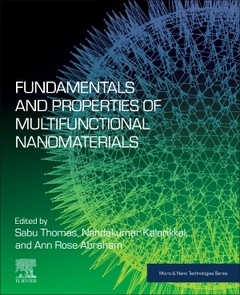Fundamentals and Properties of Multifunctional Nanomaterials Micro and Nano Technologies Series
Coordonnateurs : Thomas Sabu, Kalarikkal Nandakumar, Abraham Ann Rose

Fundamentals and Properties of Multifunctional Nanomaterials outlines the properties of highly intricate nanosystems, including liquid crystalline nanomaterials, magnetic nanosystems, ferroelectrics, nanomultiferroics, plasmonic nanosystems, carbon-based nanomaterials, 1D and 2D nanomaterials, and bio-nanomaterials. This book reveals the electromagnetic interference shielding properties of nanocomposites. The fundamental attributes of the nanosystems leading to the multifunctional applications in diverse areas are further explored throughout this book.
This book is a valuable reference source for researchers in materials science and engineering, as well as in related disciplines, such as chemistry and physics.
1. A glimpse into the fundamentals and properties of multifunctional nanomaterials Part 1. Nanoscopic solids and transport properties 2. Transport properties of nanoscopic solids as probed by spectroscopic techniques Part 2. Properties of liquid crystalline nanomaterials 3. Properties of multifunctional bionanomaterials of lipid A-phosphate in liquid phases and quasi-crystalline structures 4. Behavior of nanoparticles within liquid crystal phases Part 3. Properties of carbon-based nanomaterials 5. Characteristics of carbon nanotubes and their nanocomposites 6. Morphology-correlated mechanical properties of ionic liquid-modified multiwalled carbon nanotubes/poly(vinyl chloride) nanocomposites 7. Fundamentals and properties of multifunctional graphene and graphene-based nanomaterials 8. Fundamental photophysical properties of fluorescent carbon dots and their applications in metal ion sensing and bioimaging Part 4. Characteristics of magnetic nanomaterials 9. Magnetic properties of doped germanium nanostructures 10. Magnetic and electrochemical characteristics of carbon-modified magnetic nanoparticles Part 5. Properties of ferroelectric nanomaterials 11. Effect of particle size on structural phase transitions of lithium-modified sodium niobates (LiXNa1-XNbO3 x = 0,0.06 and 0.12) 12. BiFeO3-based multiferroic materials and their properties Part 6. Properties of plasmonic nanomaterials 13. Multifunctional plasmonic nanomaterials 14. Multifunctional gold nanoparticles for biosensing: effects of surface plasmon resonance, localized surface plasmon resonance, fluorescence, and aggregation Part 7. Engineered nanomaterials for industrial applications 15. The key role of metal nanoparticle in metal organic frameworks of UiO family (MOFs) for the application of CO2 capture and heterogeneous catalysis 16. Embracing nanotechnology concepts in the electronics industry 17. Conducting polyaniline-based nanocomposites as electromagnetic interference shielding materials Part 8. Fundamentals of 2D nanomaterials 18. Two-dimensional layered nanosheets: structure and unique properties 19. MoS2, a new perspective beyond graphene 20. Effect of defects and functionalization on mechanical and fracture properties of two-dimensional nanomaterials Part 9. The impact of nanomaterials on health and safety 21. Occupational health and safety measures of multifunctional nanoparticles in biomedical research and beyond
Dr. Thomas is the Vice-Chancellor and a Professor of Polymer Science and Engineering at Mahatma Gandhi University, India. Additionally, he serves as the Director of the School of Energy Materials at the same institution. Dr. Thomas is internationally recognized for his contributions to polymer science and engineering, covering polymer nanocomposites, elastomers, polymer blends, interpenetrating polymer networks, polymer membranes, green composites, nanocomposites, nanomedicine, and green nanotechnology. His groundbreaking inventions in polymer nanocomposites, polymer blends, green bionanotechnological, and nano-biomedical sciences have significantly contributed to the development of new materials in the automotive, space, housing, and biomedical fields. Dr. Thomas has been conferred with Honoris Causa (DSc) by the University of South Brittany, Lorient, France.
Dr. Nandakumar Kalarikkal is an Associate Professor at the School of Pure and Applied Physics and Joint Director of the International and Inter University Centre for Nanoscience and Nanotechnology of Mahatma Gandhi University, Kottayam, Kerala, India. His research activities involve applications of nanostructured materials, laser plasma, and phase transitions. He is the recipient of research fellowships and associateships from prestigious government organizations such as the Department of Science and Technology and Council of Scientific and Industrial Research of the Government of India. He has active collaborations with national and international scientific institutions in India, South Africa, Slovenia, Canada, France, Germany, Malaysia, Australia, and the United States. He has more than 130 publications in peer-reviewed journals. He also co-edited nine books of scientific interest and co-authored many book chapters.
Ann Rose Abraham, PhD, is currently an Assistant Professor at the Department of Physics, Sacred Heart College (Autonomous), Thevara, Kochi, Kerala, India. Dr. Abraham received M.Sc.
- Explains the concepts and fundamental applications of a variety of multifunctional nanomaterials;
- Introduces fundamental principles in the fields of magnetism and multiferroics;
- Addresses ferromagnetics, multiferroics, and carbon nanomaterials.
Date de parution : 08-2021
Ouvrage de 682 p.
19x23.4 cm
Thèmes de Fundamentals and Properties of Multifunctional Nanomaterials :
Mots-clés :
2D materials; Antiferroelectricity; Applications; Archimedean tiling; BiFeO3Coupling; Bioelectronics; Bioimaging; Biosensing; Cancer therapy; Carbon dots; Carbon nanotubes; Carbon; Chemical functionalization classical mechanics; CO2 capture; Composites; Conducting polymer; Conductive Multifunctional Nanoscaled Crystals; Control; Dielectric spectroscopy; DMSs materials; Electrocatalysis; Electrochemical supercapacitors; Electromagnetic interference; Electron spin resonance; Engineered nanoparticles; Exfoliation; Exposure; Ferroelectricity; Ferromagnetism; Fluorescence property; Functional properties; Geometrical defects; Germanium nanostructures; Gold; Graphene; h-BN nanosheets; Health; Heavy metal ion sensing; Heterogeneous catalysis; High-resolution calorimetry; Interatomic potentials; Ionic liquid modified Carbon nanotubes; IoT devices; Lipid A-diphosphate; Lipopolysaccharides; Liquid crystals; LSPR; Magnetic nanoparticles; Magnetic-plasmonic nanoparticles; Magnetization; Metal nanoparticles; Micro crack deflection; MOFs; Morphology; MoS2Transition metal dichalcogenides; Multiferroics; Multifunctional nanomaterials; Multifunctional; MWCNTs; Nanobotsensors; Nanomaterial; Nanoparticle; Nanoparticles; Nanostructure; Neutron diffraction; Niobate; Occupational safety; Particle size; Physicochemical properties; Plasmon; Plasmonic nanoparticles; Plasticizing effect; Polarized optical microscopy; Polyaniline; Polymorphs; Polyvinyl chloride; Printing technology; Properties; Quantum dots; Raman and infrared spectroscopy; Raman spectroscopy; Risk assessment; Risk management; Shielding effectiveness; Single phase; Small-angle X-ray scattering; Small-area electron diffraction; Smart systems; Spintronic devices; SPR; Structure; Surface modification; SWCNTs; Toxicity; Transistors; Transmission electron microscopy; UiO; Ultrasmall size; X-ray diffraction



